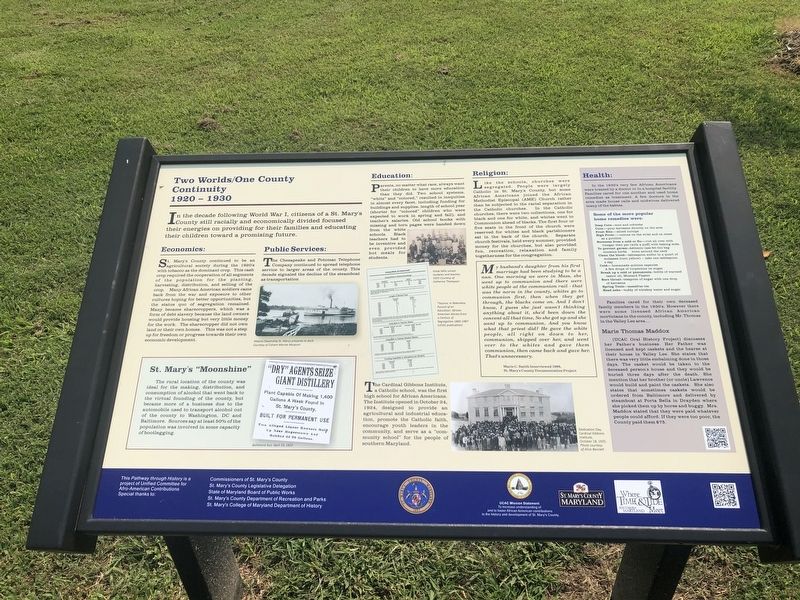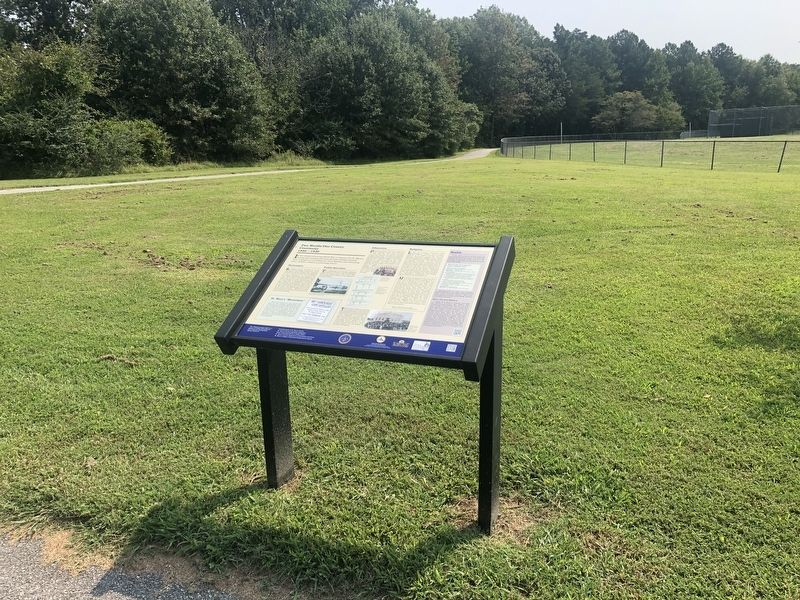Lexington Park in St. Mary's County, Maryland — The American Northeast (Mid-Atlantic)
Two Worlds / One County
Continuity
— 1920 - 1930 —
In the decade following World War I, citizens of a St. Mary's County still racially and economically divided focused their energies on providing for their families and educating their children toward a promising future.
Economics:
St. Mary's County continued to be an agricultural society during the 1920's with tobacco as the dominant crop. This cash crop required the cooperation of all segments of the population for the planting, harvesting, distribution, and selling of the crop. Many African American soldiers came back from the war and exposure to other cultures hoping for better opportunities, but the status quo of segregation remained. Many became sharecroppers, which was a form of debts slavery because the land owners would provide housing but very little money for the work. The sharecropper did not own land or their own homes. This was not a step up for freedom or progress towards their own economic development.
Public Services:
The Chesapeake and Potomac Telephone Company continued to spread telephone service to larger areas of the county. This decade signaled the decline of the steamboat as transportation.
St. Mary's "Moonshine"
The rural location of the county was ideal for the making, distribution, and consumption of alcohol that went back to the virtual founding of the county, but became more of a business due to the automobile used to transport alcohol out of the county to Washington, DC and Baltimore. Sources say at least 50% of the population was involved in some capacity of bootlegging.
Education:
Parents, no matter what race, always want their children to have more education than they did. Two school systems, "white" and "colored," resulted in inequities in almost every facet, including funding for buildings and supplies, length of school year (shorter for "colored" children who were expected to work in spring and fall), and teacher's salaries. Old school books with missing and torn pages were handed down from the white schools. Black teachers had to be inventive and even provided hot meals for students.
The Cardinal Gibbons Institute, a Catholic school, was the first high school for African Americans. The Institute opened in October 24, 1924, designed to provide an agricultural and industrial education, promote the Catholic faith, encourage youth leaders in the community, and serve as a "community school" for the people of southern Maryland.
Like the schools, churches were segregated. People were largely Catholic in St. Mary's County, but some African Americans joined the African Methodist Episcopal (AME) Church rather than be subjected to the racial separation
My husband's daughter from his first marriage had been studying to be a nun. One morning we were in Mass, she went up to communion and there were white people at the communion rail - that was the norm in the county, whites go to communion first, then when they get through, the blacks come on. And I don't know, I guess she just wasn't thinking anything about it, she'd been down in the convent all that time, So she got up and she went up to communion. And you know what that priest did? He the white people, all right on down to her, communion, skipped over her, and went over to the whites and gave them communion, then came back and gave her. That's unnecessary.
Marie C. Smith Interviewed 1986,
St. Mary's County Documentation Project
Health:
In the 1930's very few African Americans were treated by a doctor or in a hospital facility. Families cared for one another and used home remedies as treatment. A few doctors in the area made house calls and midwives delivered many of the babies.
Some of the more popular home remedies were:
Deep Cuts---soot and cobwebs
Cuts----pour kerosene directly on the area
Frost Bite----sliced turnips
High Fever-----onions on the wrist and on chest as a poultice
Soreness from a cold or flu----rub all over with vinegar then pat (with a puff) with baking soda.
To prevent germs--Asthenic (ass-fet-tic) bag contains herbs worn around the neck
Clean the blood--- tablespoon sulfur in a quart of molasses (turn yellow) -- take one tablespoon a day
Cold--- homemade quinine capsules. A few drops of turpentine on sugar
Break up a cold or pneumonia--bottle of warmed castor oil, Mustard Plaster
Sore throat--teaspoon of sugar with one drop of kerosene
Spring Tonic---sassafras tea
Head ache---toddy of whiskey water and sugar
Families cared for their own deceased family members in the 1930's. However there were some licensed African American morticians in the county, including Mr. Thomas in the Valley Lee area…
Marie Thomas Maddox
(UCAC Oral History Project) discusses her Father's business. Her Father was licensed and kept caskets and the hearse at their house in Valley Lee. She states that there was very little embalming done in those days. The casket would be taken to the deceased person's house and they would be buried three days after the death. She mentioned that her brother (or uncle) Lawrence would build and paint the caskets. She also states that sometimes caskets would be ordered from Baltimore and delivered by steamboat at Porta Bella in Drayden where she picked them up by horse and buggy. Mrs. Maddox stated that they were paid whatever people could afford. If they were too poor, the County paid them $75.
Erected by Unified Committee for Afro-American Contributions Special thanks to: Commissioners of St. Mary's County; St. Mary's County Legislative Delegation; State of Maryland Board of Public Works; St. Mary's County Department of Recreation and Parks; St. Mary's College of Maryland Department of History.
Topics and series. This historical marker is listed in these topic lists: African Americans • Churches & Religion • Education • Industry & Commerce. In addition, it is included in the African Methodist Episcopal (AME) Church series list. A significant historical date for this entry is October 24, 1924.
Location. 38° 15.666′ N, 76° 26.928′ W. Marker is in Lexington Park, Maryland, in St. Mary's County. Marker is on Rennell Avenue West, 0.2 miles east of Willows Road, on the left when traveling east. Touch for map. Marker is at or near this postal address: 21550 Willows Rd, Lexington Park MD 20653, United States of America. Touch for directions.
Other nearby markers. At least 8 other markers are within walking distance of this marker. The Great Depression and New Opportunities (a few steps from this marker); A "War to end all Wars" (a few steps from this marker); Defining Freedom and Building Community (within shouting distance of this marker); United States Colored Troops (within shouting distance of this marker); Sergeant James H. Harris (within shouting distance of this marker); United States Colored Troops (USCT) (within shouting distance of this marker); Private William H. Barnes (within shouting distance of this marker); Lexington Park (within shouting distance of this marker). Touch for a list and map of all markers in Lexington Park.
Additional keywords. Roman Catholicism
Credits. This page was last revised on September 13, 2021. It was originally submitted on September 13, 2021, by Devry Becker Jones of Washington, District of Columbia. This page has been viewed 74 times since then and 5 times this year. Photos: 1, 2. submitted on September 13, 2021, by Devry Becker Jones of Washington, District of Columbia.

